The Evolution and Impact of Sonnets Through History
The Sonnets and Sonneteers
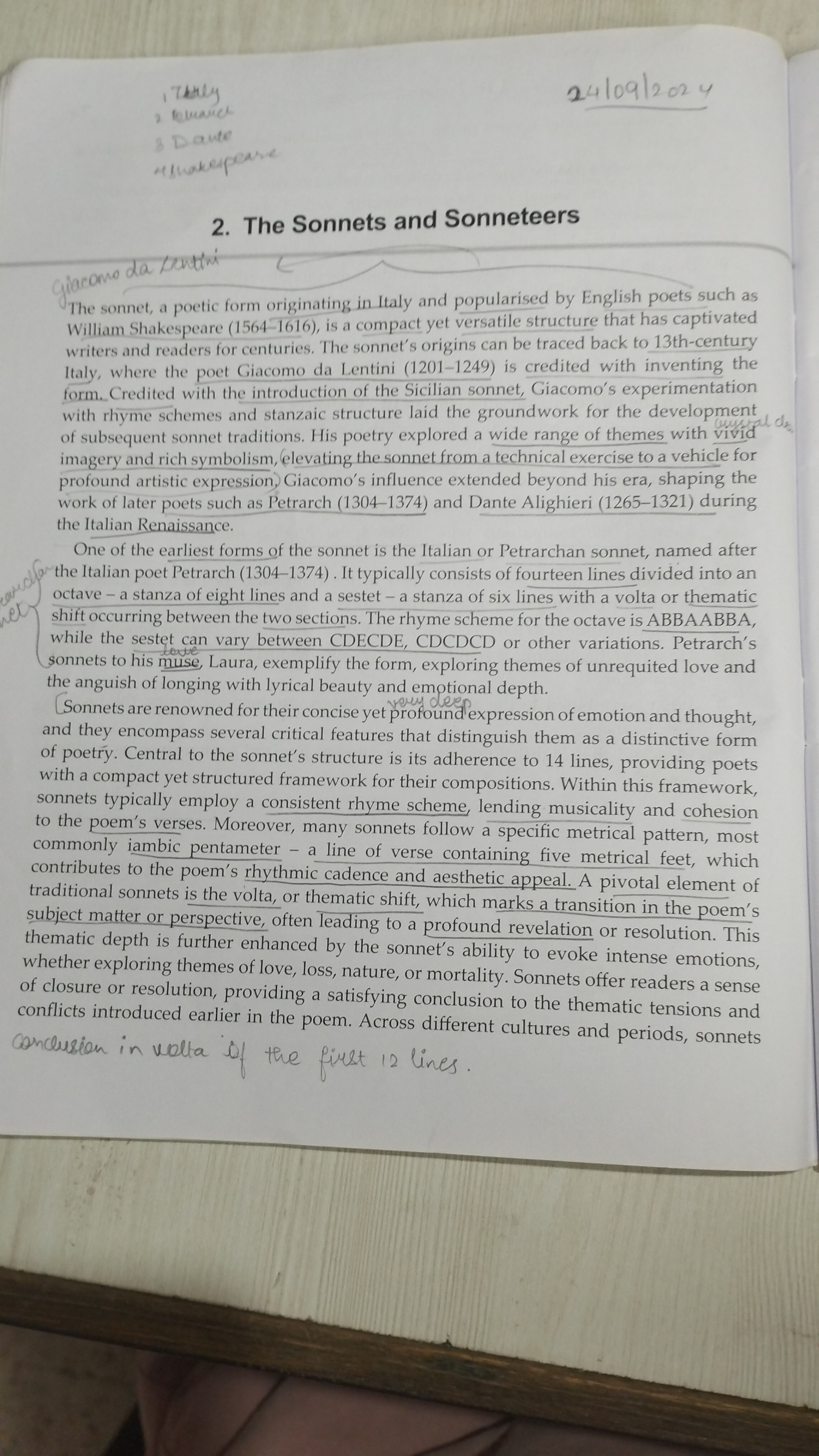
Introduction to Sonnet
- The sonnet is a poetic form originating in Italy and popularized by English poets like William Shakespeare (1564–1616).
- It is known for its versatile structure that has captivated writers and readers for centuries.
- Origins can be traced back to 13th-century Italy, primarily credited to Giacomo da Lentini (1201–1249).
Key Contributions of Giacomo da Lentini
- Invented the Sicilian sonnet.
- Introduced experimentation with rhyme schemes and stanzas, laying groundwork for future sonnet traditions.
- Explored a wide range of themes with vivid imagery and rich symbolism.
- Elevated the sonnet from a technical exercise to a vehicle for profound artistic expression.
Italian or Petrarchan Sonnet
- Named after Petrarch (1304–1374), this form typically consists of fourteen lines divided into:
- Octave: A stanza of eight lines.
- Sestet: A stanza of six lines.
- Features a volta or thematic shift between the two sections.
- Common rhyme scheme for the octave: ABBAABBA; variations for the sestet include CDEDEC or CDCDCD.
Structure and Themes
- Petrarch's sonnets often address unrequited love, such as his muse Laura.
- Sonnet structure focuses on a compact yet structured framework for compositions.
Critical Features of Sonnets
- Rhyme Scheme: Sonnets typically employ a consistent rhyme scheme, which lends musicality and cohesion to the poem's verses.
- Metrical Pattern: Commonly follows iambic pentameter, a rhythmic pattern contributing to the poem’s aesthetic appeal.
- Iambic Pentameter: A line of verse containing five metrical feet.
- Volta: A pivotal element, introducing a shift in the poem’s subject matter or perspective. This shift often leads to a profound revelation or resolution.
- Thematic Depth: Enhanced by the sonnet’s ability to evoke intense emotions, exploring themes of love, loss, nature, or mortality.
- Closure/Resolution: Provides a satisfying conclusion to the tensions or conflicts introduced earlier in the poem. This is typically found in the volta of the first 12 lines.
Conclusion
- Across different cultures and periods, sonnets remain a significant form of poetry, celebrated for their structured yet expressive nature.
Extended readings:
www.masterclass.com
What Are the Different Types of Sonnets? 4 Main ... - MasterClass
ohiostate.pressbooks.pub
History of the Sonnet – British Literature to 1800
www.poetryfoundation.org
Learning the Sonnet | The Poetry Foundation
The Sonnets and Sonneteers
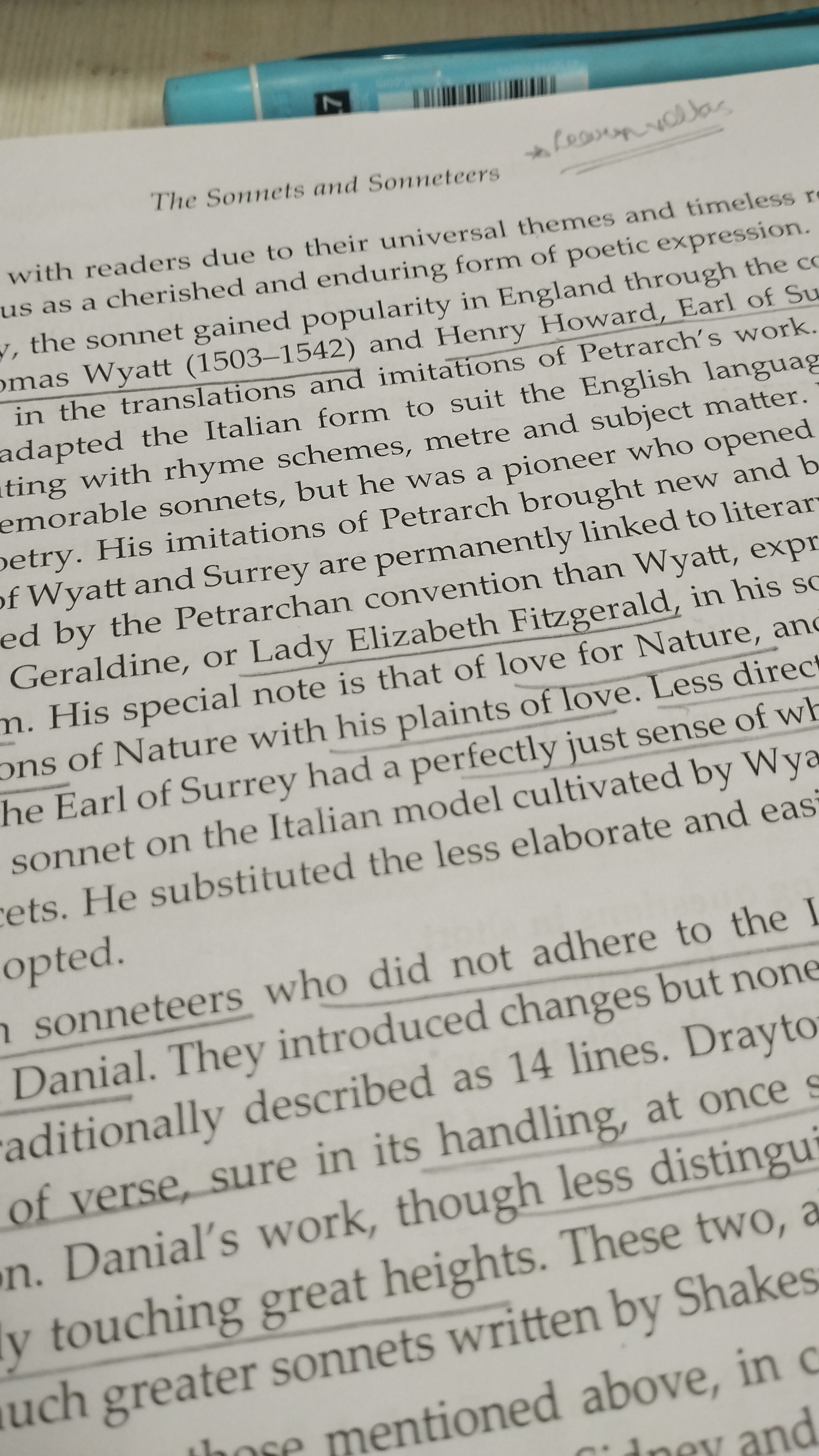
Overview of the Sonnet in England
- Introduction of the Sonnet
- Gained popularity in England through translations and imitations of works by Thomas Wyatt (1503–1542) and Henry Howard, Earl of Surrey.
- Both poets adapted the Italian sonnet form to fit English language and structure.
Key Figures
-
Thomas Wyatt
- Known for his innovations in the sonnet form.
- Engaged with Petrarch’s themes, especially love and nature. His works often reflect a personal connection to the subject matter.
-
Henry Howard, Earl of Surrey
- His sonnets express emotions related to love and nature, often utilizing a more direct approach than Wyatt.
- Contributed to the establishment of a distinct English sonnet style.
Themes in Sonnets
-
Petrarchan Tradition
- Wyatt and Surrey are linked to the Petrarchan convention in sonnets, focusing on themes of unrequited love, beauty, and nature.
- Examples include love for figures such as Geraldine or Lady Elizabeth Fitzgerald.
-
Nature and Emotion
- Sonnets often explore the relationship between human emotions and the natural world.
- Wyatt's work includes reflections on nature and personal sentiments, establishing a connection between the two.
Development of the Sonnet Form
- Changes in Structure
- Other sonneteers like Danial enhanced the form, introducing variations while maintaining the tradition of 14 lines.
- Innovations included adjustments in rhyme schemes and thematic focus.
Influence of Subsequent Poets
- Daniel and Drayton
- Both poets contributed significantly to the sonnet form, though their works are often viewed as less distinguished compared to the heights achieved by earlier figures.
- Their engagement with the sonnet laid the groundwork for later poets, including Shakespeare, whose contributions would significantly expand the sonnet's thematic and structural possibilities.
Conclusion
- The early sonneteers played a crucial role in shaping the English sonnet, influencing themes and structures still explored in modern poetry. Their ability to adapt the Italian form yielded a rich tradition that continues to resonate.
Extended readings:
www.collegehelper.in
Elizabethan sonnets & sonneteers - College Helper
www.academia.edu
Petrarchan Influence on Elizabethan Sonneteers - Academia.edu
ohiostate.pressbooks.pub
History of the Sonnet – British Literature to 1800
English Literature of the Elizabethan and Jacobean Age
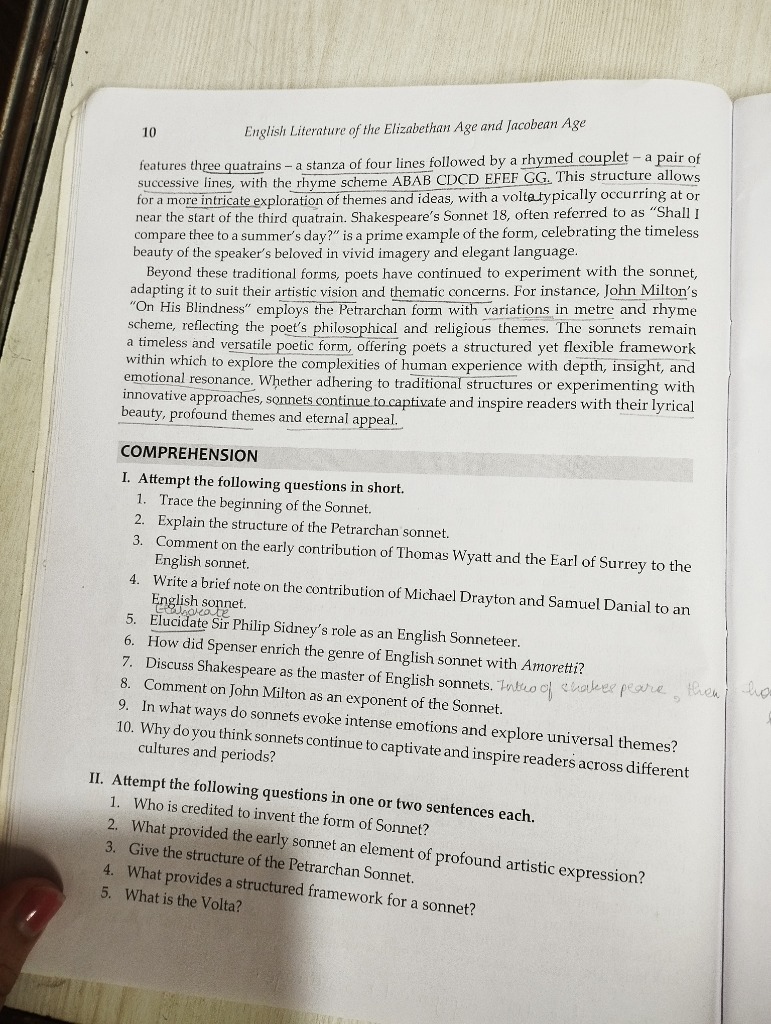
Overview of Sonnets
- Structure: The traditional sonnet features three quatrains (four-line stanzas) followed by a rhymed couplet (two-line stanza). The common rhyme scheme is ABAB CDCD EFEF GG.
- Insight: This structure allows for a detailed exploration of themes and ideas, with a volta (turn) occurring typically at the start of the third quatrain.
- Example: Shakespeare's Sonnet 18 ("Shall I compare thee to a summer's day?") celebrates beauty through vivid imagery.
Evolution and Experimentation
- Artistic Adaptation: Poets have adapted the sonnet form to express their artistic vision and thematic concerns.
- John Milton's Contribution:
- Work: "On His Blindness" employs the Petrarchan form with varied meter and rhyme to reflect philosophical and religious themes.
- Poetic Framework: The sonnet serves as a flexible framework to explore human experiences deeply and insightfully.
Characteristics of Sonnets
- Emotional Resonance: Sonnets evoke intense emotions and explore universal themes, making them resonate across cultures.
- Timeless Appeal: Despite traditional structures, sonnets continue to captivate and inspire readers with lyrical beauty and depth.
Comprehension Questions
- Trace the beginning of the Sonnet:
- Discuss its origin and influence from Italian poetry, notably through Petrarch.
- Explain the structure of the Petrarchan sonnet:
- Comprises an octave (eight lines) followed by a sestet (six lines).
- Contribution of Thomas Wyatt and the Earl of Surrey:
- Early adopters who popularized the sonnet in England, focusing on themes of love and nature.
- Michael Drayton and Samuel Daniel's contributions:
- Both poets added variety to the English sonnet, enhancing thematic and structural complexity.
- Sir Philip Sidney's role:
- A significant English sonneteer known for his artistic sophistication and thematic depth.
- Spencer's enrichment of the genre:
- Utilized innovative strategies in his Amoretti to add depth and variety.
- Shakespeare as a master:
- Renowned for his profound exploration of human emotions and experiences in sonnet form.
- Milton as an exponent:
- His work illustrates the continued evolution and thematic richness of the sonnet.
- Sonnets' capacity to evoke emotions:
- Explored through their structured yet expressive nature.
- Captivation across cultures:
- The universal themes addressed in sonnets, such as love and mortality, explain their lasting appeal.
Short Answer Questions
- Credit for the invention of the Sonnet:
- Giacomo da Lentini is often credited with inventing the sonnet form.
- Essential element of early sonnets:
- Exploration of profound artistic expression through themes like love and nature.
- Structure of the Petrarchan Sonnet:
- Octave (ABBAABBA) followed by a sestet (varied rhyme schemes like CDCDCD or CDECDE).
- Structured framework for a sonnet:
- Provides a balance between expression and form that facilitates emotional depth.
- Definition of the Volta:
- The volta is the turn or shift in thought, usually occurring at the beginning of the sestet in Petrarchan sonnets.
Extended readings:
www.ijhssi.org
[PDF] The History of English Sonnet
www.webexhibits.org
Sonnet background : Poetry through the Ages - Webexhibits
www.academia.edu
(DOC) A Short History of the Sonnet | melika sedaghat - Academia.edu
The Sonnets and Sonneteers
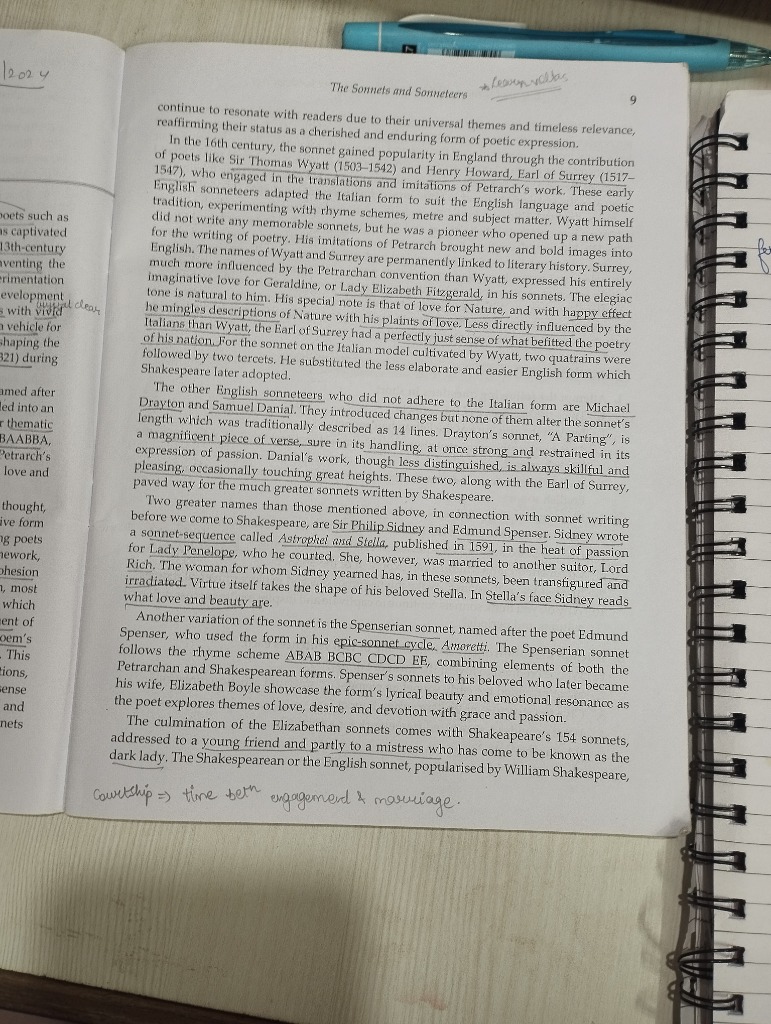
Overview of the Sonnet
- The sonnet has remained relevant due to its universal themes and timeless quality, used as a cherished form of poetic expression.
Historical Context
- 16th Century Popularization: The sonnet gained popularity in England through poets like:
- Sir Thomas Wyatt (1503–1542)
- Henry Howard, Earl of Surrey (1517–1547)
Key Characteristics
- Adaptation of the Italian form to fit English language and poetic traditions.
- Emphasis on themes such as love, beauty, and nature.
Notable Poets and Their Contributions
- Thomas Wyatt:
- Introduced the sonnet to England, inspired by Petrarch.
- Focused on themes of unrequited love.
- Henry Howard, Earl of Surrey:
- Linked closer to historical narratives in his work.
- Developed a variation of the sonnet form, substituting for more elaborate structures.
- Other Notable Figures:
- Michael Drayton: Experimented with sonnet lengths and themes.
- Daniel: Maintained less traditional forms, focusing on personal expression.
Key Themes and Styles
- Elegiac Tone: A form that expresses sorrow or lamentation, observed notably in the works of Elizabeth Fitzgerald and Wyatt.
- Innovative Variances:
- Drayton's sonnet variations emerged from traditional 14-line structures.
- Focus on exploring human emotions and skilled articulation of passion.
Elizabethan Contribution
- Sir Philip Sidney & Edmund Spenser:
- Contributed significantly to sonnet writing in the Elizabethan era.
- Sidney’s works (like "Astrophil and Stella") served as a model for blending personal desire with poetic form.
- Edmund Spenser:
- Developed the Spenserian sonnet, with a unique rhyme scheme: ABAB BCBC CDCD EE.
- Merged elements from Petrarchan and Shakespearean forms, focusing on themes of love and devotion.
Culmination of the Form
- Shakespeare's Influence:
- Shakespeare produced 154 sonnets emphasizing complex themes of love, time, and beauty.
- His work popularized the English sonnet form, integrating personal, social, and universal themes.
Conclusion
- Courtship Themes: Explore the transitions through courtship to engagement and marriage, reflective in Elizabethan sonnet literature.
- The sonnet form serves as a dynamic expression of the evolving understanding of love and human emotion throughout history.
Extended readings:
sites.udel.edu
The Elizabethan Sonnet Sequence | British Literature Wiki
ohiostate.pressbooks.pub
History of the Sonnet – British Literature to 1800
poemshape.wordpress.com
Shakespearean, Spenserian, & Petrarchan Sonnets - PoemShape
The Sonnets and Sonneteers
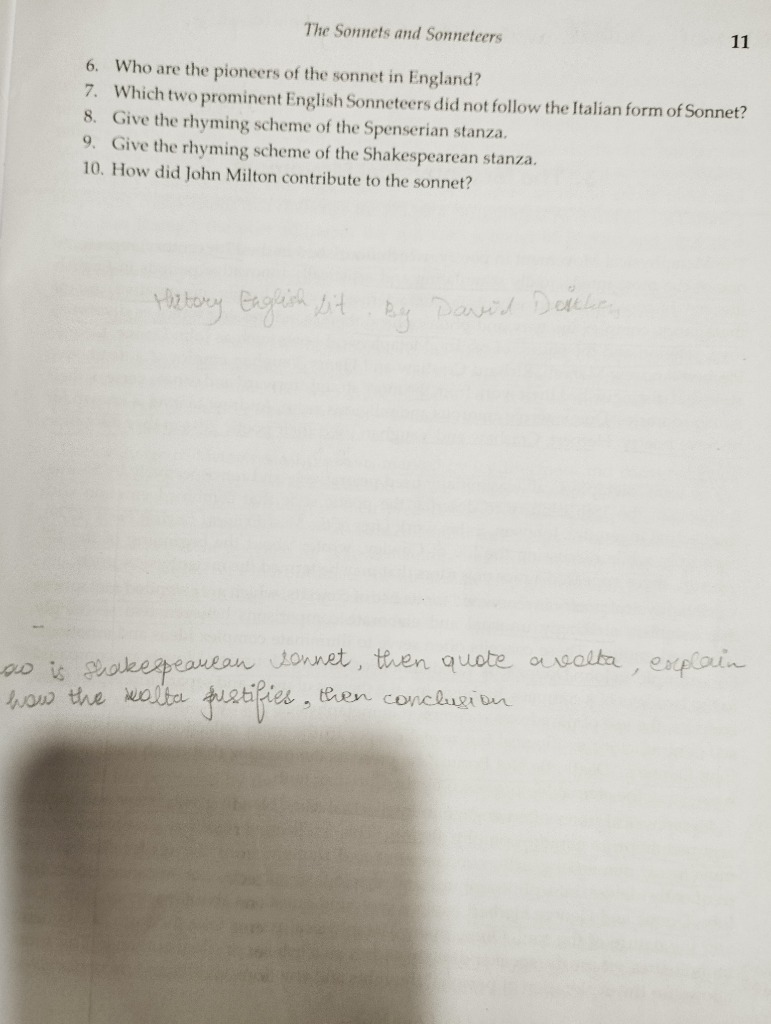
6. Pioneers of the Sonnet in England
- Notable Figures: Sir Thomas Wyatt and Henry Howard, Earl of Surrey were key figures in introducing the sonnet form to English literature.
- Insights:
- Both poets adapted the Italian sonnet (Petrarchan) to the English context, significantly influencing later poets.
- The sonnet became a primary vehicle for expressing love and personal reflection.
7. Prominent English Sonneteers Who Did Not Follow the Italian Form
- Key Figures: Michael Drayton and Edmund Spenser.
- Insights:
- These poets developed their own variations, such as the Spenserian sonnet, which consists of interlinked quatrains.
- Their works showcased a departure from the strict Italian sonnet structure, focusing instead on narrative and thematic exploration.
8. Rhyming Scheme of the Spenserian Stanza
- Structure: ABAB BCBC CDCD EE.
- Insights:
- This scheme allows for a lyrical flow, enhancing the poem's musicality.
- It exemplifies Spenser’s innovative approach to traditional forms, providing more flexibility for thematic development.
9. Rhyming Scheme of the Shakespearean Stanza
- Structure: ABAB CDCD EFEF GG.
- Insights:
- The Shakespearean sonnet features three quatrains followed by a couplet, creating a logical progression and resolution of ideas.
- The final couplet often serves as a twist or conclusion, summarizing the theme in a powerful statement.
10. John Milton's Contribution to the Sonnet
- Role: Milton’s "Sonnet 19" exemplifies his unique approach to the form, blending spiritual themes with personal introspection.
- Insights:
- His sonnets differ from those of his predecessors by imbuing a more philosophical tone, often reflecting on faith and human experience.
- Milton expanded the thematic range of sonnets, establishing them as a medium for complex ideas beyond love.
Additional Notes
- Volta: This term refers to the thematic shift in a sonnet, typically occurring between the octave and sestet in Petrarchan sonnets or before the final couplet in Shakespearean sonnets.
- Conclusion: The evolution of the sonnet in English literature showcases a journey from structured forms to individual expressions, reflecting broader cultural and personal explorations.
Extended readings:
ohiostate.pressbooks.pub
History of the Sonnet – British Literature to 1800
en.wikipedia.org
Sonnet - Wikipedia
www.masterclass.com
What Are the Different Types of Sonnets? 4 Main ... - MasterClass